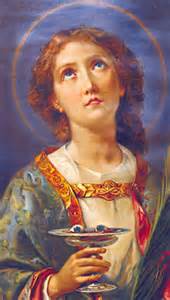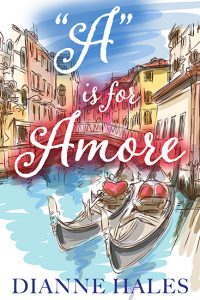
In the dark of December parts of Italy light up to celebrate a saint whose name derives from the Latin lux or lucis for light (luce in Italian).
Lucia was a young girl who lived in Siracusa on the island of Sicily in the third century. According to various legends, this saintly virgin would wear a wreath of candles as she carried food to Christians hiding in underground tunnels. When a suitor claimed to be captivated by her eyes, Lucia plucked them out and had them sent to him on a platter. In another version, she was blinded and miraculously cured.
Denounced as a Christian, Lucia was ordered to work in a brothel by Roman authorities. She refused to go, and nothing—not even a fire set under her feet—could get her to budge. One of her persecutors ultimately killed her by stabbing her in the throat.
The patron saint of sight, Lucia is often portrayed holding a plate with a pair of eyes on it. As a way of tasting the enlightenment she brings, Italians eat “gli occhi (the eyes) di Santa Lucia” usually made from bread or biscotti.
Santa Lucia gained greater fame in 1582, when famine struck Siracusa. On December 13 a boat filled with grain appeared in the harbor. Rather than processing the grain into flour, the starving people simply boiled and ate it. Sicilians honor the memory of Santa Lucia by lighting bonfires and abstaining from anything made of wheat flour on December 13. They traditionally prepare cuccìa (which rhymes with Lucia), a dessert made of whole wheat berries, cooked in water and mixed with sweetened ricotta flavored with candied orange bits and shaved chocolate.
In some parts of northeastern Italy, including the cities of Bergamo, Cremona and Verona, Santa Lucia rides a flying donkey (asino volante) to bring gifts (regali) to good children and coal (carbone) to bad ones. To make sure she stops, youngsters leave out a snack for Lucia and carrots and hay for her donkey. However, they are warned never to try to catch a glimpse of her. If they do, she may throw ashes (cenere) in their eyes and temporarily blind them.
La festa della Santa Lucia has inspired various sayings, including:
A Santa Lucia un cuecciu di cuccia — On Santa Lucia’s day a tad of cuccia. This old Sicilian proverb refers to the ever-so-slight lengthening of the daylight hours that comes with the winter solstice.
Per Santa Lucia il giorno corre via — The day of St. Lucia, one of the shortest of the year, goes fast.
Da Santa Lucia il freddo si mette in via — From St. Lucia’s day, the cold is on its way.
Santa Lucia con il fango, Natale all’asciutto — St. Lucia with mud, Christmas is dry. (If it rains on the 13th, it won’t on the 25th)
The phrase “Santa Lucia” is famous for a different reason in Italy —as a traditional Neapolitan song written in praise of the picturesque waterfront district, Borgo Santa Lucia, on the bay of Naples. In 1849 Santa Lucia became the first Neapolitan song to be given Italian lyrics and sung as a barcarola (gondolier’s song) in the early stages of the Risorgimento, the fight for the unification of Italy.
Give the gift of Italy this Christmas!
For more information and ordering links, click on the titles: LA PASSIONE: How Italy Seduced the World; LA BELLA LINGUA: My Love Affair with Italian, the World’s Most Enchanting Language; and MONA LISA: A Life Discovered.








